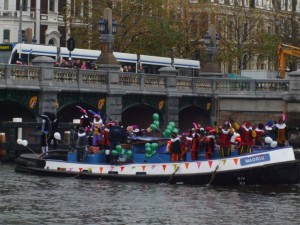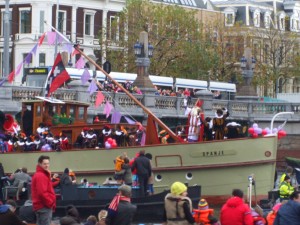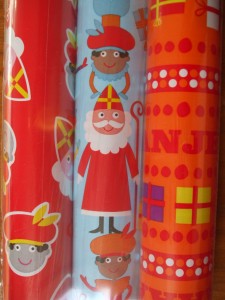
Sinterklaas arrived in Amsterdam today, November 18th–not coincidentally, the same day as the Santa Claus Parade in many Canadian cities. An estimated 300,000 children line the canals and streets of Amsterdam to greet Sinterklaas as he arrives by steamboat with his helpers, the Zwarte Pieten. The arrival of Sinterklaas (intoch van Sinterklaas) has been celebrated in Amsterdam since 1934 and transmitted on live TV since 1952. The Dutch maintain a separation between Sinterklaas and Santa Claus, who they call Kerstman (the Christmas Man).
In the Dutch tradition, Sinterklaas lives in Spain (where the remains of the actual St. Nicholas lie). In mid-October, he leaves Spain by steamboat and arrives in the Netherlands, in a different Dutch city each year, then travels throughout the country. This year he arrived in Roermond, in the southern province of Limburg. While he stays in town, he’s considered the most important person in town–even more than the town’s mayor. His arrival also starts the traditional Christmas shopping season, which used to go up until December 6th, St. Nicholas Day. On the eve of the 6th, children leave out carrots by their wooden shoes for Sinterklaas’ horse, since he travels from house to house delivering presents on a white horse.

The Zwarte Pieten, the hundreds of Moorish helpers who work for Sinterklaas, deliver the presents by sliding down each chimney (the Zwarte Pieten also traditionally had the dubious job of catching naughty children and stuffing them into burlap sacks). Traditionally, the beautifully-wrapped present would be accompanied by a funny poem describing the recipient, written by Sinterklaas. It would be opened on December 6th. Children’s shoes would be filled with marzipan and other treats.
The tradition of Sinterklaas was brought to the US by Dutch immigrants, where the tradition of the Zwarte Pieten was presumably changed to elves. The Zwarte Piet controversy can be traced to Dutch colonial times: according to folklore, Sinterklaas had a Moorish servant boy named Zwarte Piet. During WWII, Canadian soldiers who liberated the Netherlands noticed the joy that the tradition of Zwarte Piet gave to the local children during the wartime years, and held a Zwarte Pieten party with many of the characters. Today, the intoch van Sinterklaas features over 700 Zwarte Pieten. The Dutch have tried to dispel the obvious racial overtones by rewriting the story to suggest that the Zwarte Pieten are not people of African descent, but are merely dirty from sliding down chimneys all night. (Just last year, the Dutch community celebrating Sinterklaas’ arrival in Vancouver with the Zwarte Pieten resulted in opposition by the African-Canadian community). The controversy hasn’t dimmed the excitement of the local children: when I attended this year’s intoch, the children cried out for Piet, not Sinterklaas, and many sported Zwarte Piet medieval costumes and hats. Sinterklaas is dressed as a priest with red robes, bishop’s hat, and gold mitre. The Pieten hand out pounds of candy and pepernoten, bite-sized ginger cookies. Large taai-taai, shaped as Sinterklass, can also be found in local shops.

It’s interesting to see the progression of St. Nicholas from a third-century Greek bishop known for generosity and kindness to children, to stories around the world of his protection of the poor and of sailors going away to sea. In cities from Montreal to Amsterdam, the church of St. Nicholas stands at the main port of the city as a symbol of protection at sea. In Greece, the coastline features many small white chapels dedicated to St. Nicholas. After WWII, American soldiers dressed up as Santa Claus to give out toys to children in war-torn England, Italy, France, the Netherlands, and later Germany and Japan. In the Netherlands, during the weeks leading up to December 6th, kids can watch the Zwarte Pieten news on TV to see what’s going on with Sinterklaas. In Canada of course, we all await Santa’s arrival from the North Pole, where he makes toys for good boys and girls with the help of his elves. Dutch immigrants to Canada, as well other ethnocultural groups such as Greeks and Ukrainians, have helped shaped our Santa Claus tradition, which includes a parade in mid-November.
